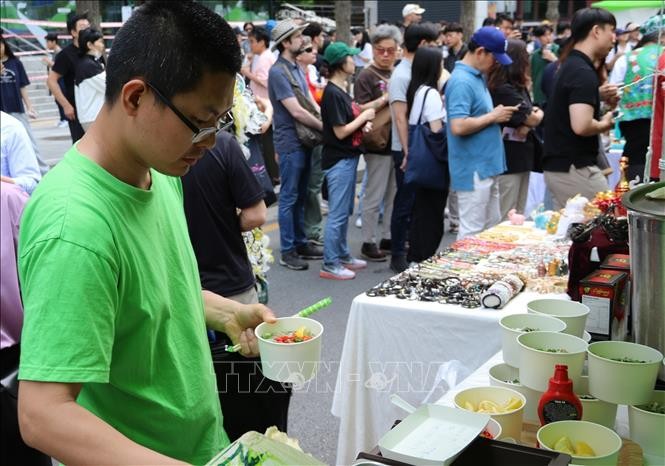Vietnamese Pho Listed Among Best Dishes To Try At Least Once In Your Life
Food trends come and go, but some ingredients are mainstays of the ‘foodie’ scene. Chefs love pushing the envelope and introducing diners to curios, from unusual cuts of meat to global dishes and wince-worthy animal innards.
Japanese scientists have proven that the way we experience various tastes changes greatly as we age. Ice cream in childhood really tastes sweeter, while many vegetables are awful because they taste bitter. While growing up we gradually lose the sharpness of perception and this is good in some sense because it widens our culinary horizons significantly. But this also means that we need to get familiar with different dishes while our taste buds are still at their peak and we can enjoy those dishes to the fullest.
Here is the list of 9 best dishes to try at least once in your life.
1. Vietnamese Pho
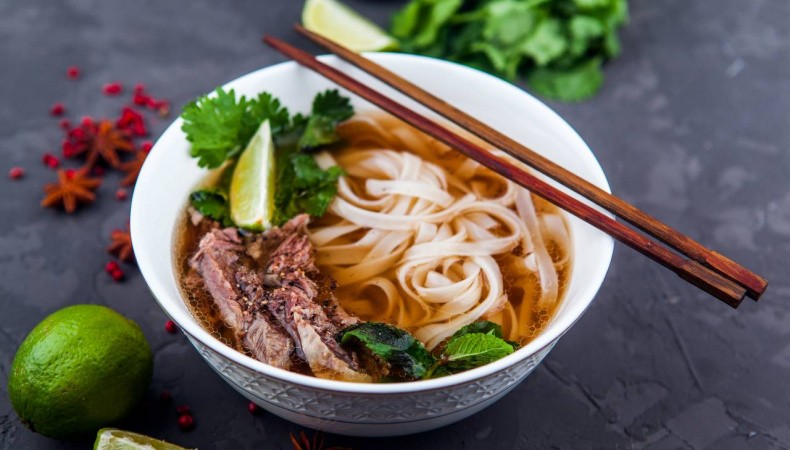 |
| Photo: Journeyonair |
Pho Vietnam, widely known as Vietnamese noodle soup, is a highlight of Vietnamese culinary. Pho is also considered as one of the most popular street food in almost all big cities of Vietnam such as Hanoi, Halong, Nam Dinh, and Ho Chi Minh City. Up to now, there has been no dish that can represent the essence of Vietnamese cuisine like pho.
Despite looking simple outside, Pho has the fascinating complexity of textures and flavors. Normally, pho Vietnam is made of rice soft noodles called “banh pho”, some slices of meat, traditional herbs and is served with consommé which is made by the simmering bone of the chicken, pork or beef. Vietnamese people love eating pho for breakfast, lunch, and dinner. Thanks to its nutrition, reasonable price as well as wonderful taste, Pho Vietnam now appears in many corners all over the world. Especially in 2014, pho Vietnam was recognized as one of the best must-try 40 dishes on the planet by the famous magazine Business Insider. In addition, 12 years earlier Pho Vietnam was named as the “next Asian dish of the day” by the Los Angeles Times.
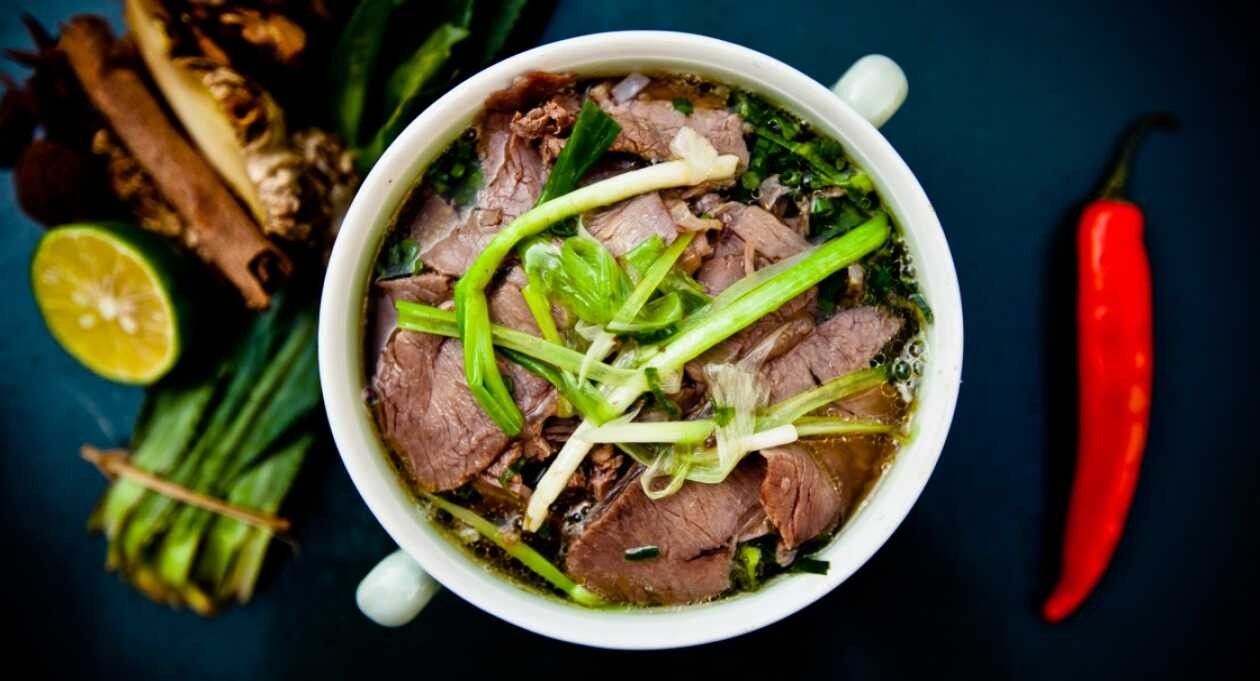 |
| Photo: Vietnam Travel |
Up to now, there have been a lot of arguments about the history of Pho Vietnam. The most popular one believes that pho Vietnam came out at the beginning of the 20th century. Some people think that pho Vietnam came from Nam Dinh City. Meanwhile, many people insist that pho Vietnam appeared for the first time in Hanoi where this dish made it a golden reputation. In terms of origin, there are two different opinions. The first one believed pho Vietnam originated from a Cantonese food in Guangdong Province, China. The other opinion asserted that it was a successful variant of French beef stew which was combined with Vietnamese traditional herbs. Pho is also believed to be a variant of an old dish called “xáo trâu”. Despite such arguments, pho was widely believed to appear to be a major part of the culinary life of urban people in the French colonial period.
In conclusion, Pho Vietnam is a harmonious harmony combination of features of three different culinary including French, Cantonese, and Vietnamese culinary. And the Vietnamese factor plays the major part. Vietnamese people didn’t create Pho for themselves. However, it’s Vietnamese people that have inherited, modified Pho, and then brought it such a golden reputation all over the world.
2. Scotch Eggs
 |
| Photo: Taste of Home |
A Scotch egg is a boiled egg wrapped in sausage meat, coated in breadcrumbs and baked or deep-fried.
As a cold item, the London department store Fortnum & Mason claims to have invented Scotch eggs in 1738, as a traveller's snack, but based this on archival material since lost. Fortnum & Mason certainly popularised Scotch eggs, including the foodstuff as part of various hampers. It is generally believed that Scotch eggs in turn derived from food the British encountered in the Raj, including a Mughlai dish called nargisi kofta ("Narcissus meatballs").
Other claims include the name coming from a nickname used by Londoners who lived around Wellington Barracks after Officers of the Scots Guards stationed there, and who developed a taste for the snack. According to Culinary Delights of Yorkshire, they originated in Whitby, Yorkshire, England, in the 19th century, and were originally covered in fish paste rather than sausage meat. They were supposedly named after William J. Scott & Sons, a well-known eatery which sold them. However, the date does not fit with the known use of the term at least 75 years earlier. It has also been suggested that they were originally called "scorch" eggs, as they were cooked over an open flame, though according to surviving recipes they were deep-fried in lard. 'Scotching' as a culinary process is also sometimes cited as the origin, though what 'scotching' was is open to interpretation, from the inclusion of anchovies to simply mincing meat. Further confusion is added by the large trade in eggs from Scotland in the 19th century, which sometimes involved dipping eggs in a lime powder, a process possibly also known as 'scotching'.
Scotch eggs are a common picnic food. In the United Kingdom packaged Scotch eggs are available in supermarkets, corner shops and motorway service stations. Miniature versions are also widely available, sold as "mini scotch eggs" "savoury eggs", "picnic eggs", "party eggs", "snack eggs", "egg bites" or similar. These contain chopped egg or a quail's egg, rather than a whole chicken egg, and sometimes contain mayonnaise or chopped bacon.
3. Phirni
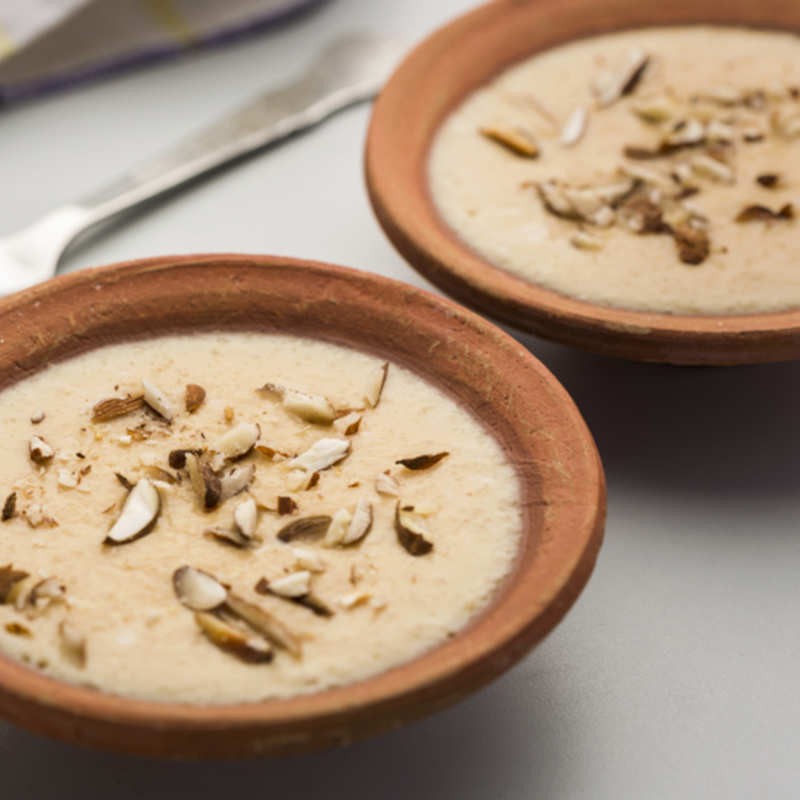 |
| Photo: Times Food |
Phirni also called as firni is a classic slow-cooked Indian sweet pudding made with basmati rice, milk, nuts, sugar and scented with cardamom powder or saffron or rose water. It is a must in North India on festive occasions or special celebrations like Diwali as well as for Karwa Chauth Festival.
Phirni is a thick and creamy pudding made from ground rice. To make the simplest and yet the best phirni recipe all you need is rice, milk, sugar, nuts and flavorings of your choice like saffron or cardamom powder or rose water.
Slow cooking is the key to make a perfect phirni. The ground rice granules are slow-cooked in milk to a creamy and thick consistency.
Phirni has a lovely aroma from the basmati rice and using aromatic ingredients like saffron, rose water or cardamom powder. Adding nuts like almonds or pistachios make it more rich and flavorful.
Firni is traditionally served in small earthen bowls called shikoras or matka. These earthen bowls absorb the extra moisture and liquids and make it more thicker. They also infuse the rice pudding with an earthy aroma. So if you want to make matka phirni then pour the cooked phirni in matka or shikoras. Cover with a lid or aluminium foil and refrigerate for few hours.
It is a much loved North Indian sweet pudding besides Rice Kheer and Vermicelli Kheer.
4. Pastel de nata
 |
| Photo: Living Tours |
Pastel de nata is a Portuguese egg custard tart pastry dusted with cinnamon. Outside Portugal, they are particularly popular in other parts of Western Europe, Asia and former Portuguese colonies, such as Brazil, Macau and East Timor. The Macanese pastel de nata was also adopted by KFC and is available in regions such as Hong Kong, Taiwan and China. In Indonesia, this pastry is especially popular in Kampung Tugu, Jakarta, a culturally Portuguese (Mardijker) enclave.
Pastéis de nata were created before the 18th century by Catholic monks at the Hieronymites Monastery (Portuguese: Mosteiro dos Jerónimos) in the civil parish of Saint Mary of Bethlehem, in Lisbon. At the time, convents and monasteries used large quantities of egg-whites for starching clothes, such as friars and nuns' religious habits. It was quite common for monasteries and convents to use the leftover egg yolks to make cakes and pastries, resulting in the proliferation of sweet pastry recipes throughout the country.
In the aftermath of the Liberal Revolution of 1820, following the dissolution of religious orders and in the face of the impending closure of many convents and monasteries, the monks started selling pastéis de nata at a nearby sugar refinery to bring in revenue. In 1834, the monastery was closed and the recipe sold to the sugar refinery, whose owners in 1837 opened the Fábrica de Pastéis de Belém. The descendants own the business to this day.
Since the opening of Fábrica de Pastéis de Belém, the original recipe of the pastel de nata is kept in a secret room. The recipe remains unchanged to this day and is known by only a few. The Fábrica de Pastéis de Belém, remains the most popular place to buy pastéis de nata around Lisbon. The shop is located just a short three-minute walk from the Jerónimos Monastery. The shop offers both take out and sit in services and sells over 20,000 pastéis de nata a day. Usually the tart is sprinkled with canela (cinnamon), and often accompanied with a bica, (a strong espresso coffee).
In 2009 The Guardian listed pastéis de Belém as one of the 50 "best things to eat" in the world and has over 50,000 reviews and ratings on Tripadvisor for its iconic pastéis de nata.
5. Bulgogi
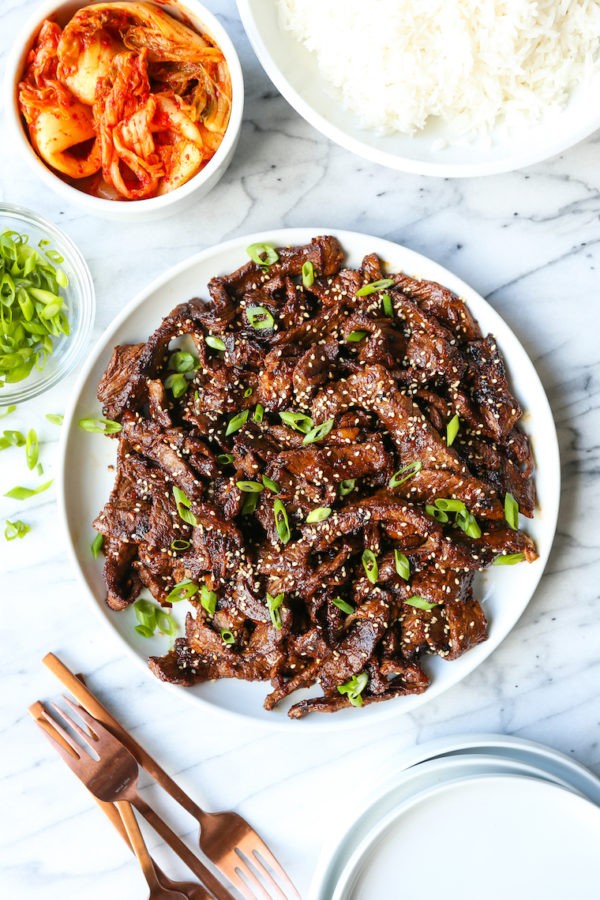 |
| Photo: Damn Delicious |
Bulgogi made of thin, marinated slices of beef or pork grilled on a barbecue or on a stove-top griddle. It is also often stir-fried in a pan in home cooking. Sirloin, rib eye or brisket are frequently used cuts of beef for the dish. The dish originated from northern areas of the Korean Peninsula, but is a very popular dish in South Korea, where it can be found anywhere from upscale restaurants to local supermarkets as pan-ready kits.
Bulgogi is believed to have originated during the Goguryeo era (37 BCE–668 CE), when it was originally called maekjeok (맥적, 貊炙), with the beef being grilled on a skewer. It was called neobiani (너비아니), meaning "thinly spread" meat,[11] during the Joseon Dynasty and was traditionally prepared especially for the wealthy and the nobility. In the medieval Korean history book Dongguksesi (동국세시), bulgogi is recorded under the name yeomjeok (염적), which means "fire meat." It was grilled barbecue-style on a hwaro grill on skewers, in pieces approximately 0.5 cm thick. Although it is no longer cooked skewered, this original type of bulgogi is today called bulgogi sanjeok (불고기 산적).
Bulgogi is made from thin slices of sirloin or other prime cuts of beef. Ribeye is also commonly used due to its tenderness and easily-cuttable texture. In addition to beef, chicken and pork bulgogi are also common ingredients used to prepare the dish. Pork belly, or samgyeopsal in Korean, is a popular cut for pork bulgogi. Much like the ribeye, it is tender and fatty which can give the meat a better taste. Before cooking, the meat is marinated to enhance its flavor and tenderness with a mixture of soy sauce, sugar, sesame oil, garlic, ground black pepper, and other ingredients such as scallions, ginger, onions or mushrooms, especially white button mushrooms or matsutake. In most cases when cooking Bulgogi, these are common ingredients. However, the ingredients used to marinate the meat can vary from chef to chef and even from family to family depending on one’s preferences and traditions. Pureed pears, pineapple, kiwi, and onions are often used as tenderizers. Sugar or other types of sweeteners such as corn syrup may sometimes also be used to add a sweeter taste. The length of time in which the meat is left to marinate also varies depending on preferences. Generally, bulgogi meat is left to marinate for less than an hour but many top chefs will even leave it overnight for the best taste. Sometimes, cellophane noodles are added to the dish, which varies by the region and specific recipe.
The most common way of preparing beef bulgogi produces a dark looking texture that is well seasoned and flavored. Spicy variations are also common where a spicy paste such as gochujang, made from chili powder, rice, fermented soybeans, barley, and salt, is added to the marinade to make the meat spicy. This is most commonly done with the pork variations.
6. Chawanmushi
 |
| Photo: Low Carb Asian |
Master the ultimate Japanese dish “Chawanmushi” today. Silky smooth savoury soft egg custard subtly and delicately flavoured, yet packed with Umami. Furthermore, this sophisticated dish can be cooked in 30 minutes.
Chawan(tea cup) mushi(steam) literally means teacup steamed egg custard. Unlike other egg custard, Chawanmushi is not sweet but it has savoury flavour packed with umami from dashi stock and topping ingredients.
The Egg mixture making Chawanmushi only requires 4 ingredients – eggs, dashi stock, soy sauce(usukuchi), and mirin. If you like softer texture Chawanmushi, the perfect ratio of eggs to Dashi stock is 1 to 3. For example if your egg weigh 50g, you need 150ml of dashi stock. If you like harder texture Chwanmushi, change the ratio to 1 to 2.5.
It is typically topped with fish cakes either (Naruto or Kamaboko), Shiitake mushrooms, Ginnan (Ginkgo nuts), and shrimps or chicken meat. Also wilted spinach or parboiled broccoli and decoratively cut carrots will add striking colour.
Both Naruto and Kamoaboko are fish cake but in different shapes. Naruto has a pink spiral pattern which resembles the Naruto whirloops in the Naruto Strait. You have probably seen this fish cake in any Ramen dish as it is often used for a ramen topping.
In Japan, Chawanmushi is very popular and often cooked at home in a special dish. It is teapot shaped and special Japanese pottery. They are commonly and readily available to purchase. They come with a little individual lid too.
7. Hamsi tava
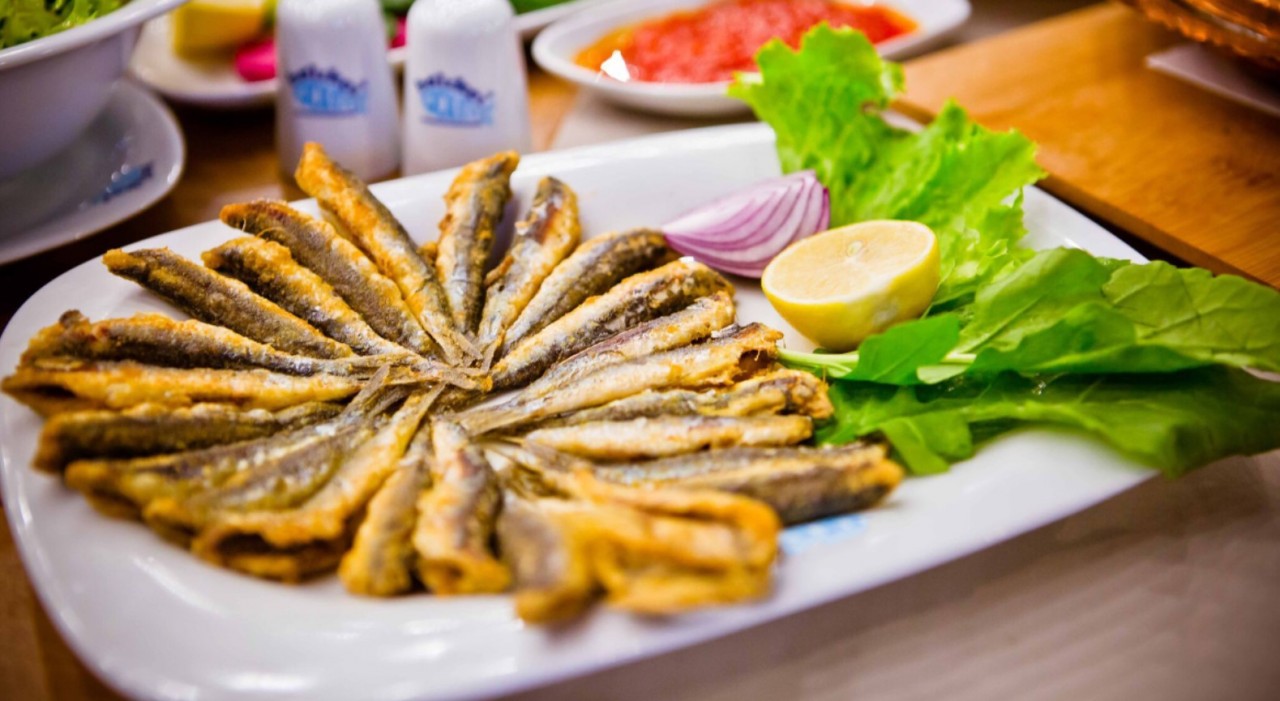 |
| Photo: Turkish Foodie |
Hamsi Tava, in English ‘Fried Anchovy’, is one of the famous Black Sea region seafood dish in Turkey. Hamsi is a small forage fish that has 144 species in 17 genera. In Turkey, they live in the Black Sea region, and their variety is called ‘European Anchovy’.
As you know Turkey is a country which has surrounded by 3 seas (Black Sea, Aegean Sea, and the Mediterranean Sea) and we have special months for certain fish varieties. Within these three seas, the Black Sea is the coldest one, and the cold means fat for fish. The colder the sea, the fattier the fish. Hamsi period continues in Turkey from November to February which the Black Sea is at its coldest period. In Turkey, we say that if you are going to eat ‘Hamsi Tava’, wait until the first snow of the year.
Hamsi’ has one of the best tastes within the forage fishes. The only downside of consuming Hamsi (European Anchovy) is the cleaning part. However, as natural, all the good things come with a price and the cleaning part is the price of this magnificent taste. If you are lucky, your local fish market may sell cleaned Anchovy. If not, you need to get dirty your hands. As the anchovies deteriorate faster than any other fish, you need the clean them as fast as you can. In Turkey, if you give extra money to the fish market guys, they clean them for you.
8. Thüringer Rostbratwurst
 |
| Photo: Koch-Mit |
Thuringian sausage, or Thüringer Bratwurst in German is a unique sausage from the German state of Thuringia which has protected geographical indication status under European Union law.
Thuringian sausage has been produced for hundreds of years. The oldest known reference to a Thuringian sausage is located in the Thuringian State Archive in Rudolstadt in a transcript of a bill from an Arnstadt convent from the year 1404. The oldest known recipe dates from 1613 and is kept in the State Archive in Weimar, another is listed in the "Thüringisch-Erfurtische Kochbuch" from 1797 which also mentions a smoked variety.
Only finely minced pork, beef, or sometimes veal, is used in production. Most of the meat comes from the upper part from around the shoulder. In addition to salt and pepper, caraway, marjoram, and garlic are used. The specific spice mixtures can vary according to traditional recipes or regional tastes. At least 51% of the ingredients must come from the state of Thuringia. These ingredients are blended together and filled into a pig or sheep intestine. Thuringian sausages are distinguished from the dozens of unique types of German wursts by the distinctive spices (which includes marjoram) and their low fat content (25% as compared to up to 60% in other sausages).
According to German minced meat law, the Hackfleischverordnung, raw sausages must be sold on the day of their creation or until the closing of a late-night establishment. Previously grilled sausages have a shelf-life of 15 days, and sausages immediately frozen after their creation may be stored for 6 months.
9. Poutine
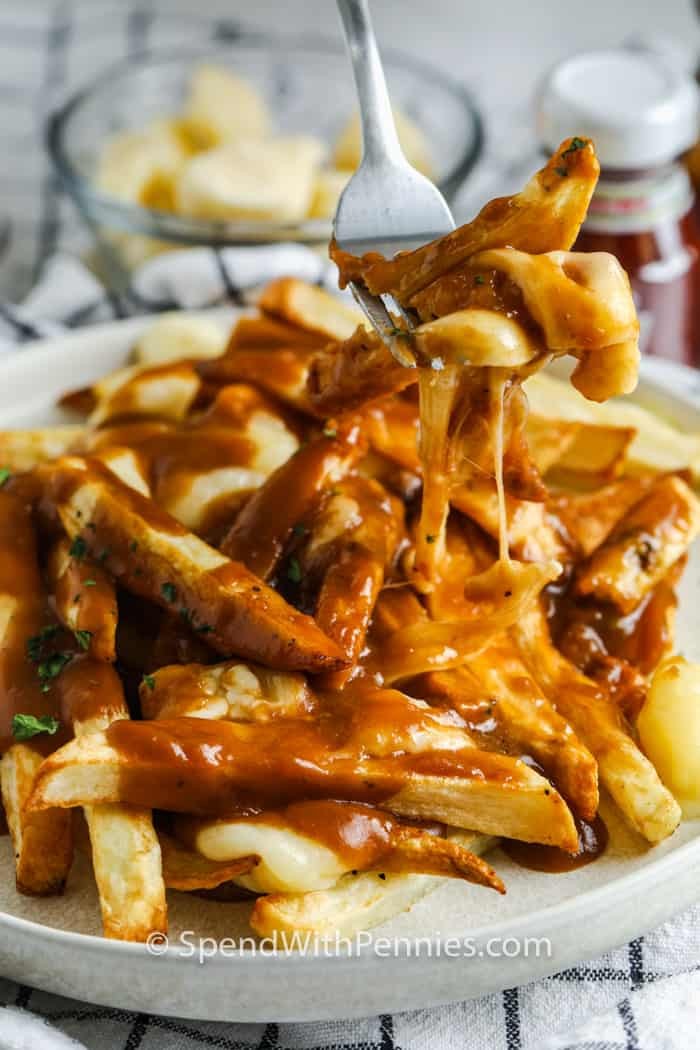 |
| Photo: Spend with the Pennies |
Poutine is a dish of french fries and cheese curds topped with a brown gravy. It emerged in Quebec, Canada, in the late 1950s in the Centre-du-Québec region, though its origins are uncertain and there are several competing claims of having invented the dish. For many years it was perceived negatively and mocked, and even used by some to stigmatize Quebec society. Poutine later became celebrated as a symbol of Québécois culture and the province of Quebec. It has long been associated with Quebec cuisine, and its rise in prominence has led to popularity throughout the rest of Canada, in the northern United States, and internationally.
Annual poutine celebrations occur in Montreal, Quebec City, and Drummondville, as well as Toronto, Ottawa, New Hampshire and Chicago. It has been called "Canada's national dish", though some believe this labelling represents cultural appropriation of the Québécois or Quebec's national identity. Many variations on the original recipe are popular, leading some to suggest that poutine has emerged as a new dish classification in its own right, as with sandwiches and dumplings.
To maintain the texture of the fries, the cheese curds and gravy are added immediately before serving the dish. The hot gravy is usually poured over room-temperature cheese curds, so they are warmed without melting completely. The thin gravy allows all the fries to be coated. The serving dish typically has some depth to act as a basket for the fries so that they retain their heat. It is important to control the temperature, timing, and the order in which the ingredients are added to obtain the right food textures—an essential part of the experience of eating poutine.
Freshness and juiciness of the curds is essential. Air and moisture seep out of the curds over time, altering their acidity level. This causes proteins to lose their elasticity, and the curds to lose their complex texture and characteristic squeaky sound when chewed. The curds should be less than a day old, which requires proximity to a dairy. While Montreal is 60 kilometres (37 mi) from a cheese plant in Mirabel, restaurants and specialty cheese shops outside of dairy regions may be unable to sell enough curds to justify the expense of daily deliveries. Furthermore, Canadian food safety practices require curds to be refrigerated within 24 hours, which suppresses the properties of their texture. This has resulted in poutineries which specialize in the dish; busy poutineries may use 100 kilograms (220 lb) of curds per day. Poutineries which are too distant from dairies may make their own cheese curds on site, in batches every few hours, to ensure a fresh and steady supply.
 | Discover Alberobello – The Unique Trulli Town of Puglia Somewhere in Southern Italy, there is a small town with grey looking trulli houses that make the place look like a fairy tale land and ... |
 | Under The Sea: Explore 7 Stunning Underwater Cities and Towns In The World We have seen submerged cities and towns in the movies and novels of Jules Verne, but you probably do not know that they, infact, exist ... |
 | Interesting Tales: 5 Luxurious Hotels That Were Once Prisons Prisons are dreadful places, and some of old prison buildings were renovated and made into luxurious and famous hotels in the world. |
Recommended
 World
World
India reports 9 Pakistani Aircraft Destroyed In Operation Sindoor Strikes
 World
World
Thailand Positions Itself As a Global Wellness Destination
 World
World
Indonesia Accelerates Procedures to Join OECD
 World
World
South Korea elects Lee Jae-myung president
Popular article
 World
World
22nd Shangri-La Dialogue: Japan, Philippines boost defence cooperation
 World
World
Pakistan NCRC report explores emerging child rights issues
 World
World
"India has right to defend herself against terror," says German Foreign Minister, endorses Op Sindoor
 World
World






